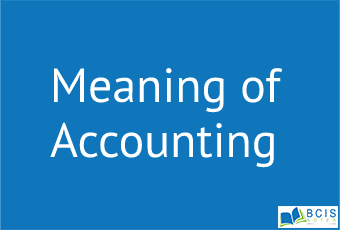
The Conceptual Foundation of Accounting
The Conceptual Foundation of Accounting is a process of identifying summarizing, classifying, and recording the business activities to provide economic information to its users. Accounting is a source of all information that acts as a foundation of planning, controlling, and decision making.
Accounting as a Language of Business
Accounting is commonly viewed as simply a technical calculative part of financial transactions. Accounting is a science that follows principles and principles are those which have cause and effect relationship. Accounting is also an art that always attempts to make a user satisfied with the use of various presentation tools and skills.
Forms of business organizations
Business is an economic activity, which is related to continuous production and distribution of goods and services for satisfying human wants under uncertain market conditions. Business organizations have different structures or forms. There are three forms of business organizations that are widely followed.
- Sole Proprietorship
- Partnerships
- Corporations/Joint Stock Company
Sole Proprietorship
This form of business organization is owned, managed, and controlled by a single individual. Normally small businesses are run as sole proprietorships. The entire profit is taken by the sole trader at the expense of bearing the business risks individually. In Nepal, a sole trading concern is established under the Private Firm Registration Act, 2014.
Advantages
- Easy to establish
- Owner controlled
- Tax advantage
- Effective decisions
- An incentive to Work hard
- No profit-sharing
- Secrecy
- Quick decision
Disadvantages
- Limited capital
- Unlimited liabilities
- Lack of effective management
- Narrow scope
- No idea sharing
- No loss sharing
- Lack of Perpetual existence
Partnerships
A business owned by two or more persons associated as partners is called a partnership. A partnership is normally forward to collect huge resources for the establishment and expansion of a business. Besides the economic resources, the partners also bring unique skills and competencies. A partnership is not a taxable entity. Hence, it gets tax advantages. In Nepal, all the partnership organizations are established according to Nepal Partnership Act, 2020.
Advantages
- Easy to establish
- Shared control
- Broader skills and resources
- Tax advantages
Disadvantages
- Unlimited liability
- Chances of misunderstanding among the partners
- Lack of perpetual existence
- Lack of sufficient capital
Corporations/Joint Stock Company
A corporation/company is a legal business entity owned by a large number of stockholders. An investor in a corporation receives a share of stock to indicate his ownership claim. The share of stocks is easily transferable or sold. A company uses a common seal to formalize and legalize its activities. It is managed and run by the representative of shareholders known as a member of the Board of Directors (BOD) who are also the shareholders of the company. In Nepal, a company is established under the Nepal Company Act, 2063.
Advantages
- Large capital
- Transferability of shares
- Limited liability
- Perpetual existence
- Democratic management
- Efficient management
- Public confidence
Disadvantages
- Difficulty information
- Delay in decision
- Excessive legal provisions
- Lack of secrecy
Types of Activities Performed by Business Organizations
All businesses are involved in three types of activities namely financing, investing, and operating. The details about each type of activity are given below:
- Financing Activities
- Investing Activities
- Operating Activities
Financing Activities
All business gets started with financing. More precisely money is needed to start a business. Thus, financing activities are related to managing funds for the business. The financing activities which inflow cash may be an issue of share capital, issue of debenture, bonds or long-term notes, borrowings or loan from a bank, etc. and the activities which outflow cash may be payment of dividend, the redemption of debentures and bonds, repayment of notes, bank loans and borrowing, etc.
There are two sources of accumulating funds for business:
- Debt
- Equity
| Financing Activities | |
| Inflows | Outflows |
| Issue of capital stock, debentures, bonds, and notes | Cash payment to owners to redeem the shares. |
| Borrowing of a short or long-term loan | Repayment of borrowing |
| Loan on mortgage | Cash dividend paid |
Investing Activities
There is a natural progression in a business from financing activities to investing activities. Investing activities are the acquisition and disposal of long-term assets and other investments not included in cash equivalents. In other words, the investing activities of business entity are those which are related to the purchase or sale of physical business assets, investments, or intangible assets.
| Investing Activities | |
| Inflows | Outflows |
| Disposal of plant, properties, equipment, etc. | Purchase of plant, properties, equipment, etc. |
| Sales of shares, debentures, bonds, etc. from other company | Purchase of shares, debentures, bonds, etc. of other company |
| Sale of patent, trademark, goodwill, etc. | Purchase of patent, trademark, goodwill, etc. |
Operating Activities
Once a business generates fund invests in various assets, it begins to operate. It starts generating from the sale of goods and services called revenues. Likewise, it has to incur expenses into several headings that assist to generate revenues. The operating activities include cash revenues earned from the sale of merchandise inventory or other expenses incurred to make that item into a saleable condition.
| Operating Activities | |
| Inflows | Outflows |
| Sales revenue | Purchase of inventory |
| Services revenue | Cost of goods sold |
| Interest revenue | Selling expenses |
| Dividend received | Marketing expenses |
| Administrative expenses | |
| Interest expenses | |
| Income taxes | |
You may also like Introduction to Organizational Behavior || Fundamentals of Organizational Behavior

Leave a Reply